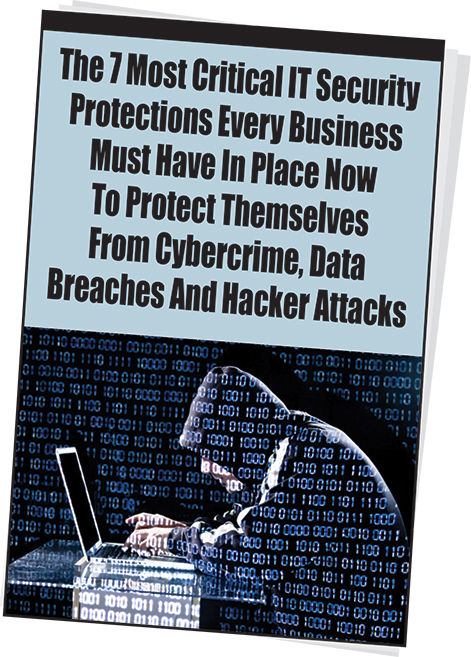
May 2018

Made to Stick
By Chip and Dan Heath
Why, in today’s chaotic media climate, do conspiracy theories, abject falsifications and urban legends circulate effortlessly throughout the country while most businesses struggle to make their ideas “stick”? In their popular 2007 book Made to Stick, educators and idea collectors Chip and Dan Heath employ a wealth of anecdotes, case studies and data to discover what makes some ideas last and others fade away within the week. Using this information, they create a compelling set of principles that can be used by anyone seeking to make a lasting mark on the world.

The Shocking Truth Behind Cybercrime Threats
And What You Can Do About Them Now
Today’s technological innovations have empowered small businesses to do things that would have been utterly unimaginable even 15 years ago. To remain competitive in a constantly shifting landscape, we’ve become more dependent on software and hardware to house even the most basic structures of the companies we run.
Meanwhile, these technologies are evolving at breakneck speed. Every day, there’s a slew of new devices to consider, a pile of new updates to install and a new feature to wrap our heads around. Every morning, we wake up and the digital world is thrillingly new.
But all over the world, there’s an insidious network of criminals keeping up with this insanely rapid pace of progress. With every new security measure designed to protect our digital assets, there are thousands of hackers working around the clock to determine a new way to break through. An estimated 978,000 fresh new malware threats are released into the world each day. The term “up to date” doesn’t mean much anymore in the wake of new developments arriving minute by minute.
There’s a price to pay for the increased efficiency and reach enabled by the digital age. We’ve all heard the story before. A massive, multinational corporation neglects some aspect of their security and falls victim to a crippling large-scale cyberattack, with criminals lifting millions of dollars in customer data and digital assets. Equifax, J.P. Morgan, Home Depot, Yahoo!, Verizon, Uber and Target – these narratives are so commonplace that they barely raise an eyebrow when we read about them in the news.
Most business owners wrongly assume that these incidents have no bearing on their own companies, but these high-profile incidents account for less than half of data breaches. In fact, according to Verizon’s 2017 Data Breach Investigations Report, 61% of attacks are directed at small businesses, with half of the 28 million small and medium-sized businesses (SMBs) in America coming under fire within the last year.
“We’ve all heard the story before. A massive, multinational corporation neglects some aspect of their security and falls victim to a largescale, crippling cyber-attack...”
It’s hard to imagine how you can possibly protect yourself from these innumerable threats. Statistically, you can be all but certain that hackers will come for your data, and there’s no way to know what new tool they’ll be equipped with when they do.

You may not be able to foresee the future, but you can certainly prepare for it. With research, education and resources, you can implement a robust security solution into the fabric of your business. That way, you can send hackers packing before they get their hooks into the organization you’ve spent years building from the ground up.
One huge leap you can make right now for the security of your business is to simply realize that cyber security isn’t something you can install and leave alone for years, months or even days. It requires regular updates and the attention of professionals to ensure there’s no gap in your protection. There are new shady tactics being used by criminals every day, but there are also fresh protocols you can use to stave them off.
Small business owners assume that since they don’t have the resources of a Fortune 500 company, they don’t have the means to invest in anything but the barest of security. Obviously, hackers know this and target SMBs in droves. The bad news is that most businesses’ paper-thin barriers won’t save them in the event of a crisis. The good news is that it doesn’t take thousands upon thousands of dollars to implement a security system that will send the hackers packing.
Free Report: The 7 Most Critical IT Security Protections Every Business Must Have In Place Now To Protect Themselves From Cybercrime, Data Breaches And Hacker Attacks

978,000 NEW malware threats are being released every day, and businesses (and their bank accounts) are the No. 1 target. To make matters worse, a data breach exposing client or patient information can quickly escalate into serious reputational damage, fines, civil lawsuits and costly litigation. If you want to have any hope of avoiding a cyber-attack, you MUST read this report and act on the information we’re providing.
Claim Your FREE Copy Today at https://www.rangersolutions.com/cybercrime/

4 Tips To Ensure Fear Won’t Destroy Your Business
Fear can be a good thing if it keeps us from stepping too close to the edge of a cliff or motivates us to dodge out of the way of a speeding car. But in business, you shouldn’t let fear dictate the core of your decision-making process. Here are four ways to manage your fear, move through it and make the best possible calls for the future of your company.
1. DO A COST-BENEFIT ANALYSIS.
It’s the oldest and easiest trick in the book. Make a list with two columns – one that includes everything you worry could go wrong in your organization, and the other with everything you hope will go right. Taking a step back and looking at this list will help you avoid surrendering to fear at the ouset and make your decisions based on facts instead.
2. FIND YOUR SPOCK AND MCCOY.
Any classic Star Trek fan will remember that whenever Capt. James T. Kirk had to make a decision, he gathered his two most trusted advisors: Dr. McCoy and Spock. He could always count on McCoy to offer a “gut” perspective based on emotion and fear, whereas Mr. Spock consistently offered a measured, logical approach to any situation. Then the captain, better understanding the extremes of the situation, could make a levelheaded decision. Find the members of your team who will help you see the full spectrum of any situation, listen to them and make decisions accordingly.
3. TRUST, BUT VERIFY.
When Ronald Reagan spoke about his decision-making process for the nucleararms policy and the United States’s relationship with the Soviet Union, he took a balanced approach. Though he said he would “trust” that the Soviets would abide by their agreement, he would “verify” that they were indeed holding up their end of the bargain. To be a great leader, you need to have a certain level of faith that things are going right. However, you’ve also got to pay attention, verify that people are doing what you’ve asked them to do and make appropriate changes along the way to ensure that your trust is respected and warranted.
4. BUTTERFLIES ARE A GOOD THING.
My daughter Madison is an actor, and she has the proverbial butterflies in her stomach before every performance. In many ways, it’s the fuel that drives her onstage. As a leader, don’t let the butterflies in your stomach stop you from moving forward with a decision or from considering a new idea. Instead, let that little bit of anxiety motivate and drive you toward success.

As the founder of Petra Coach, Andy Bailey can cut through organizational BS faster than a hot knife through butter, showing organizations the logjams thwarting their success and coaching them past the excuses we all use to avoid doing what needs to be done. Andy learned how to build great organizations by building a great business, which he started in college. It then grew into an Inc. 500 multimillion-dollar national company that he successfully sold and exited.
Shiny New Gadget Of The Month:

This Reverse Microwave Can Quick-Freeze Food And Drinks
Way back in 1946, technology gave us the capability to pop some leftovers into the microwave and heat them up within minutes. But if we had a warm beer in our hands or needed a tray of ice quick, we were out of luck. Enter Frigondas’s line of new kitchen technologies, which enable users to flashfreeze dishes, rapidly chill beverages and create crystal-clear ice within minutes. Couple this revolutionary feature with Frigondas’s host of advanced heating abilities, and you’ve got a kitchen appliance that’s set to change the microwave game for good.
The only problem is that the technology isn’t yet available for purchase, with no release date in sight. Still, experts expect it to hit the market within a year or two, though it remains to be seen whether it will justify what’s sure to be a hefty price tag.
Millennials Are Key To Your Business’s Success

Business owners can no longer afford to ignore or actively disdain millennials. With a projected $1.4 trillion in spending power by 2020, this vital demographic is becoming key for companies of all shapes and sizes. But as a generation that has come up in one of the most volatile job and financial markets in decades – with the traditional paths to success all but wiped out – they’re an understandably wary bunch. To court these finicky but powerful spenders, businesses must find ways to be honest and transparent, using value-based marketing to develop a true connection between brand and consumer. Capterra Blog, 11/7/17
3 Big Trends Businesses Need To Adopt Now

When the online publication Small Business Trends surveyed nearly 500 small and midsize-business owners across the country last February, they found that technology has become more important than ever in companies of all sizes.
Though CRM is often an expensive and lofty goal for time-strapped businesses, it drastically increases growth once it’s implemented and understood. In fact, Small Business Trends found that “growing SMBs are twice as likely as their stagnant counterparts to rely on CRM in their daily lives.” Along with these cohesive programs, synchronizing business data across platforms is becoming a priority as well, especially when providing a holistic view of key customer information.
Even artificial intelligence has begun to crop up in the small business market, albeit slowly. Still, it’s clear that the fastestgrowing businesses are using automation and predictive sale forecasting nearly twice as much as their stagnant counterparts. SmallBusinessTrends.com, 2/14/18
The Internet Of Things: Are You Okay Playing Offense?
Adjusting your home’s thermostat and hot water heater back to normal temperatures as you board a plane on your way home isn’t just cool, it’s incredibly handy. However, the network of these and other connected devices – often called “the Internet of Things” (IoT) – poses one of the biggest security problems of the modern era.
Most people think about changing their computer password regularly and their ATM PIN occasionally, but they almost never consider changing the password the programmable thermostat ships with from the factory, meaning that anyone who can access the manual has access to your thermostat.
Usually, attackers who target IoT devices don’t want to cause you a problem. Instead, they use your device along with 20,000 other thermostats as “soldiers” to battle against a website or e-mail server. By flooding these sites with traffic, they can shut them down or stop your e-mail server from delivering your messages.
You should adopt a strict offensive posture against these types of threats in your life and business. If there is even a suspected problem with one of your IoT devices, pull the plug. Your heater may be cold when you get home, but at least your data will be safe.
Cartoon Of The Month




